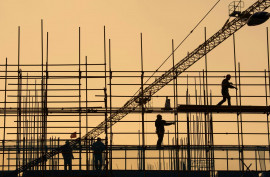
The present demand for natural gas stands at 8 billion cubic feet (bcf) during the winters, whereas national production from conventional sources stands at 4.2 bcf. It is no secret that the supply for natural gas has been unable to meet demand for many years now. New fields, brought online over the last 3 years, have been barely able to maintain the current levels of production.
The reason for the stagnation in output is reduced production from the main natural gas fields: ie, Sui (which has seen a fall of 4.4% year-on-year), Qadirpur (which has seen a fall of 2.0% year-on-year), Zamzama (which has seen a fall of 23.1% year-on-year), Sawan (which has seen a fall of 1.1% year-on-year), Kandhkhot (which has seen a fall of 5.5% year-on-year) and Miano (which has seen a fall of 4.8% year-on-year). These fields together contribute nearly half of the total natural gas production of Pakistan.

These major gas fields (especially Sui) have been responsible for the supply of cheap natural gas for the last 40 years. However, they are past their peak production capacity, as is the case for any finite natural resource. The trend we see in our natural gas production over the last five years is that it has plateaued-out and is expected to decline rapidly from here on in. This has forced policy-makers to look for alternative sources of domestic natural gas; ie tight gas, shale gas and coal-gasification (converting coal to gas).
In this article I intend to address the question whether shale gas can help resolve our energy crisis and what it means for our environment.
To answer the first question we must first look at the role natural gas plays in our economy. Natural gas as a source of energy to the economy constituted (48%) of the total. In terms of consumption, the breakdown is as follows: power sector (35.5%), general industrial use (25%), domestic use (15.20%), fertiliser (both feedstock and fuel) (15.90%), transport (CNG) (4.60%). These sectors are dependent on the cheap and abundant supply of natural gas. The said supply has allowed our industries (in particular textile, but also other industries including plastic) to remain internationally competitive. Note that natural gas is used both as fuel and as a feedstock for the manufacturing of a number of chemicals and products – ammonia fertiliser is one such example. Therefore, the provision of natural gas is essential for the smooth running of our economy. So, where will we get our natural gas if we are running out of conventional sources? The most promising source is shale gas.
Geological studies show that gas could can be found in deeper, denser, “unconventional” shale formations (called plays). These plays act as both a source of gas (because shale is where natural gas is actually formed) and as its reservoir. Natural gas is stored in shale in three forms: free gas in rock pores, free gas in natural fractures, and adsorbed gas on organic matter and mineral surfaces.
In the early 2000s, a combination of two existing techniques led to a breakthrough, allowing American companies to produce shale gas. One of them horizontal drilling – drillers penetrate the shale laterally and vertically, which exposes greater surface area of the rocks for extraction and enables multiple wells to be created from each drill pad. The other is hydraulic fracturing (or fracking), a process involving water, sand and a chemical mixture pushed down a well at thousands of pounds of pressure which cracks the shale and releases the hydrocarbons.
Preliminary studies have shown that at least 33 trillion cubic feet (out of 204 trillion cubic feet) of unconventional gas reserves trapped in rocks is recoverable with available technology. The Balochistan Basin, the Suleiman Foredeep Basin and the Lower Indus Basin offer significant potential in this regard. As technology improves, so will the recoverability and the cost of production.
Provided enough incentive and facilities, the project of shale gas is technically and financially feasible. That being said, the production of natural gas from shale is not without its hazards. In addition to being technologically demanding and expensive to produce, the process can be very dangerous for the environment. The liquid used in fracking contains chemicals that are harmful to humans and our habitat. Ingredients include water and sand (98-99.5%). The remaining chemicals can be hydrochloric acid (initiates cracks), methanol (inhibits corrosion), glutaraldehyde (kills bacteria), and ethylene glycol (winterises product). In terms of weight, even 0.5% can amount to many tons of toxic material per drill pad. Chemicals used in the United States by local companies are known to be carcinogenic, mutagenic, cause chemical pneumonia, and toxic to aquatic organisms.
The biggest risk from these chemicals is in the form of water contamination. These shale gas plays are supposed to be many layers of impenetrable rocks under the water table, but when the fracking fluid goes down the well it can leak. Well walls are normally made of two layers of steel casing and two layers of heavy-duty cement: nonetheless, the risk exists. In the US, there have been many reports of ground water contamination as well as high levels of methane in water wells. Therefore any production must be tightly regulated and supervised.
The second possible source of contamination is the large amount of produced (waste) water that comes back out of the well. This chemical-laced water requires treatment before disposal or reuse. Its treatment and disposal is an important and challenging aspect of production.
Due to these and other environmental hazards, the production of shale gas should not be allowed to take place near populated areas or where our sources of water are present. It is clear that the exploration of natural gas is necessary if our economy is to survive, let alone grow. However, and as stated above, the exploration has to be supervised to prevent any environmental risks.
The writer is a barrister-at-law and an advocate at the Lahore High Court
Published in The Express Tribune, February 11th, 2013.
Like Business on Facebook to stay informed and join in the conversation.



1719211536-0/BeFunky-collage-(81)1719211536-0-165x106.webp)



















COMMENTS
Comments are moderated and generally will be posted if they are on-topic and not abusive.
For more information, please see our Comments FAQ